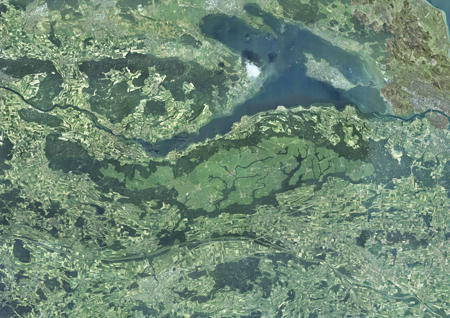Thurgau – Projekte für die Stillen Zonen

Professors: Prof. Roger Diener, Prof. Marcel Meili,
Mathias Gunz, Christian Mueller Inderbitzin
Project commissioned by Think Tank Thurgau
Since June 2006, a project team of ETH Studio Basel has been elaborating concrete projects for the “quiet zones” in the Canton of Thurgau on behalf of the Thurgau Think Tank, a foundation with private and public participation. This research is a continuation of a study on Switzerland completed in 2005 with the publication of “Switzerland – an Urban Portrait”.
In a first phase, the urban typologies in the territory of the Canton of Thurgau defined in the book on Switzerland were studied in more depth and defined. This first phase resulted in a more precisely specified and partially revised pattern of the current forms of urbanization in the Canton of Thurgau. The most surprising part of this image was the phenomenon of a “centrifugal” constellation: Since the region lacks an actual urban centre, the urban networks of Thurgau are directed outward, towards the metropolitan region of Zurich, the urban network of St Gallen-Gossau-Wil, and Constance. The quiet zones of the Canton of Thurgau are located in all those regions where the forces of this constellation more or less neutralize each other. As border areas in between the metropolitan and urbanized figures, they are eminently important. They are, so to say, the cement that holds together the identity of Thurgau. This identity is essentially based on the rural landscape and agricultural production, which is, however, increasingly under pressure because of its lack of profitability. Therefore, the goal of the second phase consisted in defining potentials that would allow these quiet zones to break out from the current logic of protectionism and prohibition characterizing these regions.
Starting with the realization that these quiet zones, too, are home to diverse configurations, projects were developed for two concrete sites within the zones designed to offer alternative scenarios of development. The project comprises a cultural landscape park on the Seerücken between Thurtal and the Lake of Constance as well as a parkway – an alternative to the T14 highway – between Weinfelden and Romanshorn. Both designs start from the assumption that the landscape is the greatest potential of the quiet zones; however, they deal with it in quite different ways. The conditions and specific features and qualities of the respective sites constitute the points of departure. In the case of the cultural landscape park, this is a cultural landscape that is still “intact” and seems to be as yet almost untouched by external influences. The design strives to preserve this landscape by superimposing a new and additional use, providing it with a form and name.
The parkway was created under different premises. It links two diverging parts of the canton and activates a region in the center of the quiet zone that was once already urbanized and seems eminently suitable for future development (of a settlement). Besides, the parkway is designed to stimulate landscape-based and dramaturgical aspects to be included in the current plans for a highway: After all, a road is not just a technical challenge, but also a design challenge and may create added value as a “machine of perception”.
The cultural landscape and the parkway are ultimately elements of one and the same larger image: Preservation and development describe a twin figure. For while one region in the quiet zone allows, or even demands, development, the other is, in a manner of speaking, “drained of energy” and allows us to preserve its landscape and keep it free.
By mid-April 2008, the study will be presented to a larger public within the scope of the Think Tank Thurgau charter meeting. On this occasion, a paper published by Niggli Verlag will be released as well.
PROJECTS: SWITZERLAND: AN URBAN PORTRAIT, DIPLOMAS, PUBLICATIONS: THURGAU: PROJEKTE FÜR DIE STILLEN ZONEN, PEOPLE: PROF. MARCEL MEILI, PROF. ROGER DIENER, CHRISTIAN MUELLER INDERBITZIN, MATHIAS GUNZ

